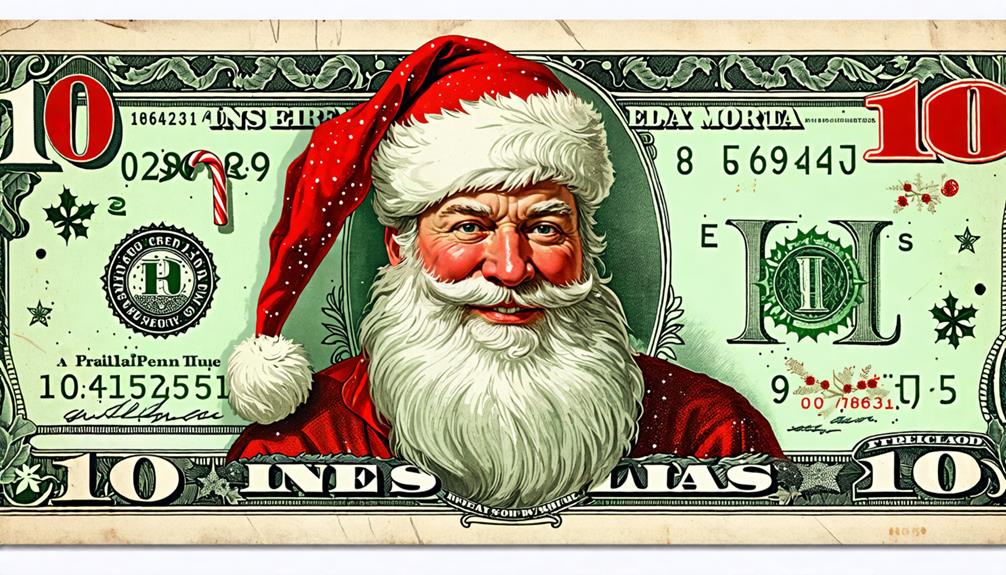You might be surprised to learn that Santa Claus has graced U.S. currency, but it's true. Since the 1850s, the jolly old elf has appeared on various banknotes, particularly in the era of obsolete currency. These unique pieces of financial history offer a fascinating glimpse into the intersection of American folklore and economic practices. While you won't find Santa on modern bills, the legacy of these holiday-themed notes continues to captivate collectors and historians alike. But what drove banks to feature such an unconventional figure on their currency, and how did it impact the public's perception of money?
Key Takeaways
- Santa Claus featured on U.S. currency as early as the 1850s, appearing on banknotes issued by various banks.
- The Howard Banking Company of Boston issued five-dollar notes featuring Santa Claus.
- Twenty-seven obsolete notes depicting Santa were issued by banks across eight different states.
- St. Nicholas Bank of New York City displayed Santa delivering gifts on their banknotes.
Historical Santa Currency

While you mightn't expect to see Santa Claus on your money today, the jolly old elf actually graced U.S. currency as far back as the 1850s.
The Howard Banking Company of Boston pioneered this trend, featuring Santa on their five-dollar bank notes. This holiday-themed currency wasn't just a festive gimmick; it served as a strategic move during a period of economic uncertainty.
Banks across eight states issued a total of 27 obsolete notes depicting Santa Claus before the federal government centralized currency printing in 1861.
Remarkably, the St. Nicholas Bank of New York City showcased Santa delivering gifts on their bills.
These unique pieces of United States financial history have since become highly sought-after collector's items, fetching significant sums due to their rarity and historical significance in the nation's banking evolution.
Significance and Cultural Impact
Three key factors highlight the significance and cultural impact of Santa Claus's appearance on U.S. currency in the 1850s.
First, it demonstrates Santa's growing cultural significance as a symbol of holiday spirit and American folklore. His presence on banknotes from 21 banks across eight states shows how widely embraced he'd become.
Second, it reflects the strategic use of festive imagery by banks to make their notes more desirable in a competitive market. This marketing tactic played a role in shaping American financial history before the establishment of official US currency.
Modern Holiday-Themed Money

Since the 1980s, Santa Dollars have emerged as a popular form of modern holiday-themed money, blending festive cheer with legal tender. You'll find Santa's jolly face adorning $1 and $2 bills, courtesy of a removable sticker that doesn't compromise the currency's legal status, as confirmed by the US Treasury Department.
These festive notes have raised millions for charity since 1985, making them a meaningful stocking stuffer. The design cleverly allows the presidential portrait to peek through, maintaining the bill's integrity.
You'll also encounter similar concepts like Bunny Bucks and Cupid Cash, all promoting charitable giving and festive spirit. While banks may hesitate to accept stickered bills, you can easily remove the decoration before use.
Santa Dollars exemplify how holiday-themed money can spread joy while retaining its practical function as currency.
Conclusion
You've discovered a fascinating piece of American numismatic history. Santa's presence on U.S. currency highlights the intertwining of commerce and culture.
While you won't find St. Nick on modern bills, these rare notes serve as valuable collectibles and reminders of a unique era.
They're a demonstration of Santa's enduring influence and the creative ways financial institutions once engaged the public.
Next time you're handling cash, remember there's more to money than meets the eye.

Leave a Reply